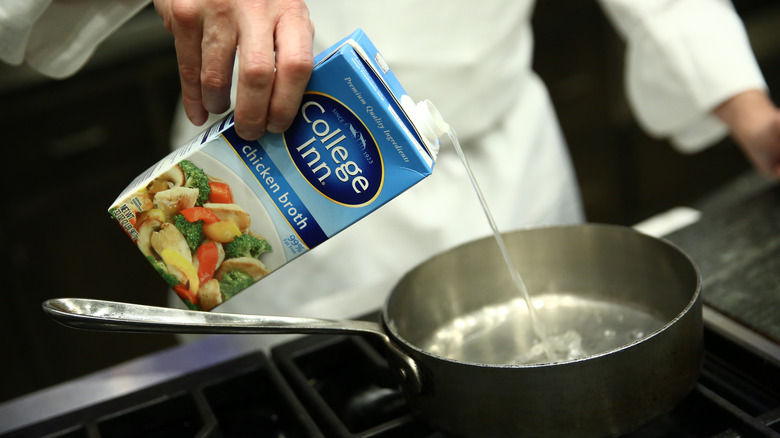Why Store-Bought Beef Stock Isn't The Best Choice For Soup
When making homemade beef stock or broth for soup is a little too much to ask, store-bought cartons seem like the next best thing. Before you head to checkout, however, you might want to read the fine print on the label.
According to the "Food Standards and Labeling Policy Book" — which is not an Oprah's Book Club bestseller but rather an official document sanctioned by the USDA and the Food Safety and Inspection Service (FSIS) — store-bought beef broth and stock are required to contain a maximum Moisture Protein Ratio (MPR) of 135:1, with the former representing the dilutant and the latter representing the protein. Should a product exceed that ratio, it must be labeled as "beef-flavored broth."
In other words, that store-bought stock in your cart is mostly water, flavored with yeast extracts to mimic the flavor of beef. Labeling such products as beef broth or stock is akin to dropping a chocolate-covered espresso bean in a 20-ounce cup of milk and calling it a mocha; you'll taste the difference. Here's what to use in its stead.
The freezer is your friend
If you cook with beef stock often — for, say, beef minestrone soup — store-bought versions aren't worth the money. Don't quote us on this, but we're pretty sure Ina Garten, queen of the "store-bought is fine" maxim, would agree. You're better off making it from scratch. Hear us out: While beef stock is one of the most time-consuming meaty elixirs (our recipe listed above takes about 14 hours), it also freezes beautifully. Carve out a weekend to make it at home and reap the benefits for up to five months.
Don't feel like monitoring a Dutch oven for half a day? Make stock at home in a slow cooker for a more hand-off process. The marrow bones, oxtails, and shanks can cook in water and aromatics for up to 24 hours; all you have to do is add the ingredients to the pot and strain it once it's done. When that time comes, save yourself from thawing and refreezing your entire batch each time you want to use some stock by divvying it up among a few freezer bags or airtight containers in one- or two-cup portions.
Stock swap
Let's say you desperately don't want to cook your beef stock from scratch but you need its rich flavor for soup. In a pinch, spring for Better Than Bouillon, a meaty concentrate that takes all the flavor of old-school bouillon cubes and presents it as a paste, which makes it easier to adjust the flavor. While it contains some of the same yeast extracts that pose as beef in liquid stocks and broths, it also boasts a higher amount of concentrated beef stock, lending a more robust flavor to your soup.
An even better option is to use a low-sodium chicken or vegetable stock. While store-bought chicken stock and broth are implicated in the same dilutant-to-protein rule as their beef counterpart, the USDA and FSIS allow poultry protein to shine a bit brighter at an average ratio of 60:1. That means store-bought chicken stock and broth contains more flavor from actual chickens.
If you're torn between brands, check out the ingredient lists to see which vegetables appear first for an idea of their flavor profile. If the stock goes heavy on onions, that's a good sign; the allium is known to take on a meaty flavor when cooked. That explains the richness of French onion soup, which can be made to taste meaty even without its usual beef stock. Meanwhile, store-bought vegetable stock might be the purest and most flavorful option. After all, there's no federal regulation against packing a stock with a medley of produce.


